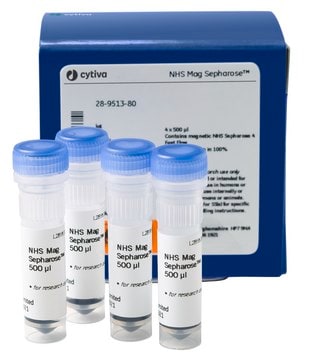H8280
N-Hydroxysuccinimidyl-Sepharose™ 4 Fast Flow
matrix fast-flow highly cross-linked 4% beaded agarose
Synonym(s):
N-Hydroxysuccinimidyl-Agarose
About This Item
Recommended Products
form
isopropanol suspension
extent of labeling
16-23 μmol per mL
technique(s)
protein array: suitable
matrix
fast-flow highly cross-linked 4% beaded agarose
matrix active group
N-hydroxysuccinimide active ester
matrix spacer
6 atoms (when ligands are coupled by displacement of NHS)
storage temp.
2-8°C
Looking for similar products? Visit Product Comparison Guide
General description
Application
Features and Benefits
- Specifically recommended for coupling of small amino-containing proteins and peptides in process-scale applications
- High level of pre-activation, which gives a high degree of substitution of the selected ligand
- NHS coupling method enables chemically stable ligand attachment
Legal Information
signalword
Danger
hcodes
Hazard Classifications
Eye Irrit. 2 - Flam. Liq. 2 - STOT SE 3
target_organs
Respiratory system
Storage Class
3 - Flammable liquids
wgk_germany
WGK 1
flash_point_f
53.6 °F
flash_point_c
12 °C
ppe
Eyeshields, Gloves, type ABEK (EN14387) respirator filter
Choose from one of the most recent versions:
Certificates of Analysis (COA)
Don't see the Right Version?
If you require a particular version, you can look up a specific certificate by the Lot or Batch number.
Already Own This Product?
Find documentation for the products that you have recently purchased in the Document Library.
Customers Also Viewed
Our team of scientists has experience in all areas of research including Life Science, Material Science, Chemical Synthesis, Chromatography, Analytical and many others.
Contact Technical Service











